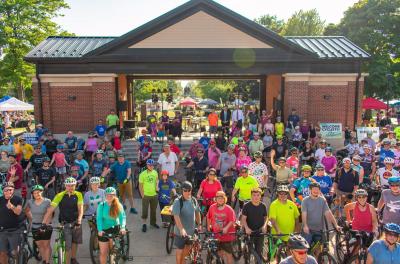Gaining Ground on the Active Erie Plan
Working to make travel safer for vulnerable road users despite squeaky wheels
Like approximately 10 percent of all American adults during the pandemic, my family started bicycling. I've had my 1979 Schwinn Collegiate three-speed since the early 2000s, so I dragged it out of the garage and had it tuned up at John Adams Cycling and Fitness. I bought an attachable trailer from a local sporting goods store to tow my toddler along, and my older child was given a bike through a family hand-me-down.
We hit the road a great deal in the summer months, riding from our West Bayfront home and enjoying the bike lane across West Sixth Street through Frontier, connecting to the multi-use path alongside Cascade Creek, across the Bayfront, and back up the hill by the Water Works — usually walking our bikes halfway; it's a doozy, especially with the toddler downforce — to the multi-use path that runs along the bluff at Bayview Park, where we'd often cool down at the splash pad oasis. It has made for fun, adventurous summers. I've seen my daughter's confidence grow as she has led in front, navigating the roads, and employing the safety measures we have taught her.
This lighthearted cycling story would be even more idyllic if I could say that this level of safety, planning, and care existed throughout the city. The aforementioned trail is one of very few intentional bike paths in the City of Erie. Traveling by bicycle with my children has made me acutely aware of the real lack of safe biking infrastructure in the city. Not including multi-use paths, there are fewer than two miles of dedicated bike lanes in the city (by comparison, the city of Norwalk, Connecticut — with roughly the same population as Erie — has 30 miles of dedicated bike lanes). So I was thrilled when I heard that the city was planning to seriously work on it.
The Active Erie Plan
The Active Erie plan was launched in 2019 when "the city of Erie began a master planning process that focuses on building a network of bike and pedestrian facilities throughout the community," according to the Active Erie website. The goal of the plan is to update Erie's bicycle and pedestrian infrastructure to include more safe, multimodal options on an interconnected route throughout the city, adding relatively inexpensive bike and pedestrian friendly lanes, signage, and street level upgrades to make travel safer for cyclists, pedestrians, and, ultimately, motorists.
This plan started with multiple public planning meetings, which allowed any interested citizen from throughout the City of Erie to voice their opinions, concerns, and hopes to the hired consulting firm Whitman, Requardt, and Associates (WRA) — a nationally recognized engineering, architectural, construction management, and environmental firm specializing in transportation — along with the mayor, City Council, and an impressively large steering committee representing key stakeholders (including the City of Erie traffic engineer, the fire department, the planning commission, the planning director, Erie Public Schools, the EMTA, Erie Arts and Culture, the Erie Community Foundation, the Erie Downtown Partnership, the Mayor's Disability Roundtable, Millcreek Township, the Metropolitan Planning Association, Bike Erie, the Health Department, refugee representation, and PennDOT).
During the pandemic, public meetings were paused and instead, multiple surveys were sent out requesting public input on the proposed bicycle and pedestrian infrastructure improvements. These surveys indicated that nearly 60 percent of people agree that bicycle amenities needed to be improved. There was also a well-publicized public bike ride in October of 2020 that allowed any interested citizen, including the steering committee and stakeholders, to ride along to (or meet up at) different public areas where WRA was proposing a bike lane, while they set up presentation materials for citizens to learn more about the projects, and voice concerns or ideas. This event was open to the public and was attended by the mayor himself (who was, ironically, nearly clipped by a car while riding along).
After this period of public input, and a hefty amount of work from the consultants, the planning department, and the steering committee, the rollout of the first leg of the Active Erie plan was presented in January of 2023. This is a long range plan with an ultimate goal of having all work completed throughout the city by 2042. As a starting point, the plan focuses on where safe cycling is truly lacking: north to south routes throughout the city.
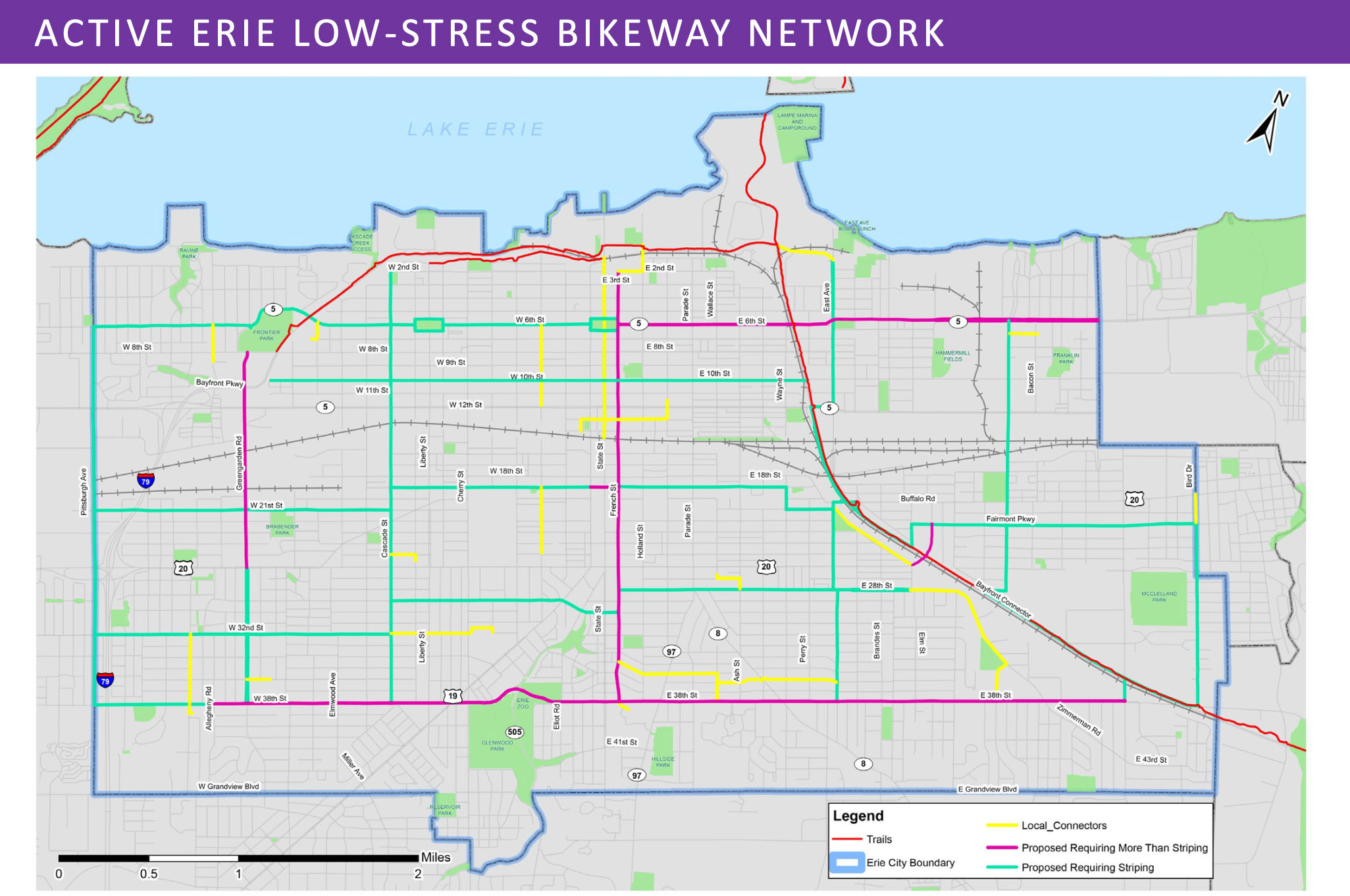 This map, published on the City's Active Erie plan website, shows all of the proposed bike lane improvements planned throughout the city, which will connect all routes to a network that will allow vulnerable road users safer access.
This map, published on the City's Active Erie plan website, shows all of the proposed bike lane improvements planned throughout the city, which will connect all routes to a network that will allow vulnerable road users safer access.
The Active Erie plan focused proposed bike lanes on streets that are "less stress," and so steered away from busier, congested north to south thoroughfares, with initial routes proposed for Greengarden Boulevard and French Street. These streets will eventually connect to a complete network of bike lanes throughout the city that will allow cyclists — or those using other forms of mobility besides a motor vehicle (often referred to as vulnerable road users) enhanced safety and protection as they navigate the city. It is worth noting that the funding for the bike infrastructure improvements on Greengarden and French has already been secured through grant funding from the Metropolitan Planning Organization (MPO) and that funding cannot be used for anything else.
Eric Brozell, Active Erie steering committee member and bicycle training coordinator for the Sisters of St. Joseph Neighborhood Network, states, "The Active Erie concept really is about making our streets safe for the most vulnerable. Few of us living today know of a time when cars didn't come first on our streets. When our streets are safe for the most vulnerable, they will be safer for all street users, including pedestrians, people on bikes, people using wheelchairs, and cars."
Other planned bike routes include West and East Sixth and 10th streets, connecting the bike lanes in the west part of the city to the downtown corridor, and continuing east to Franklin Avenue and Bird Drive. Southbound routes will ultimately connect at 38th Street, creating multiple paths of dedicated bike routes connecting all corners of the city. But the plan needs to start somewhere and that starting point happens to be on Greengarden Boulevard.
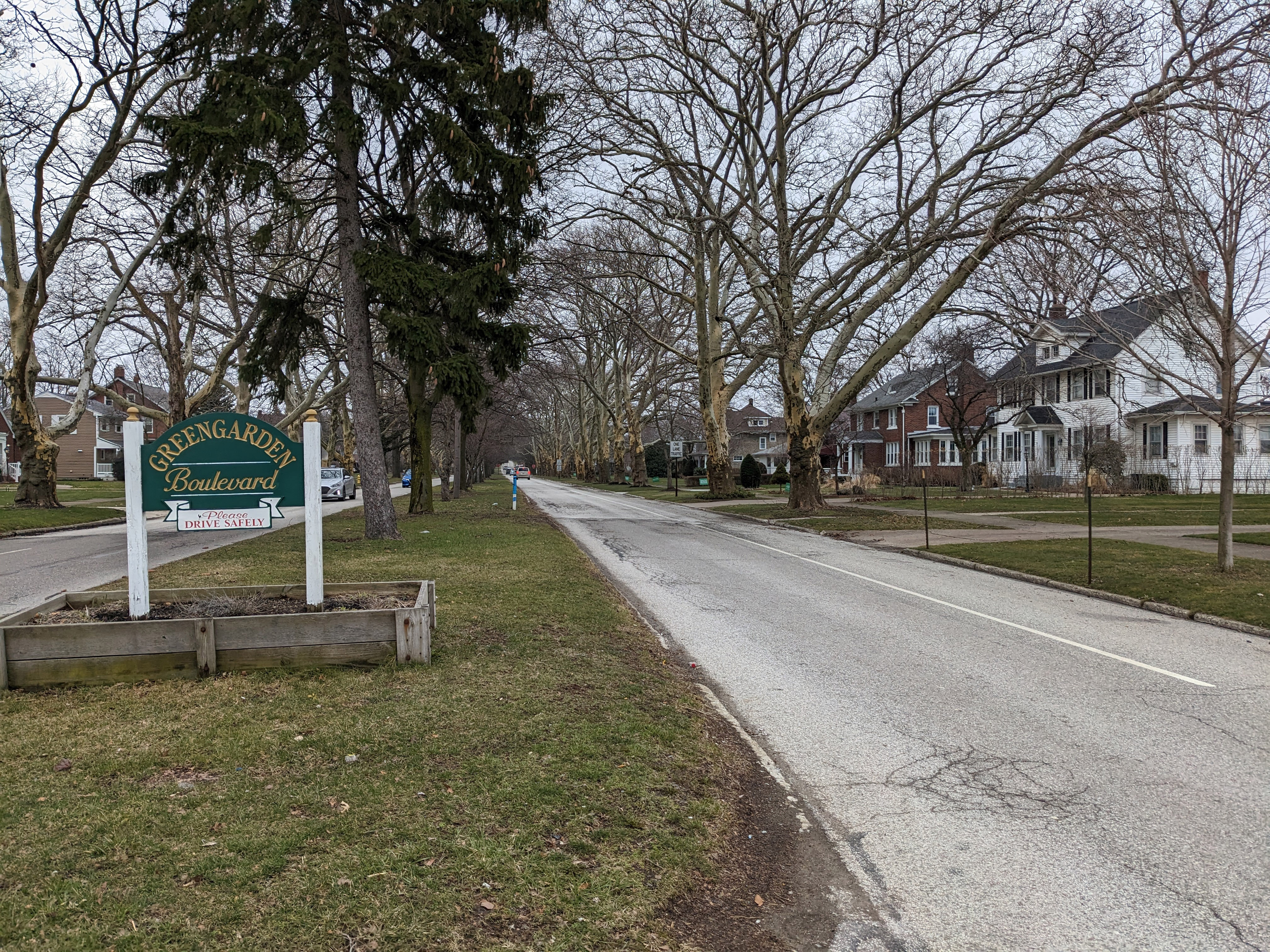 The residents of Greengarden Blvd. use their ample driveways for parking. At the time this photo was taken, there was not a single car parked on the street in southbound spaces from West 26th Street to 38th Street — there was only one car parked in the northbound lane.
The residents of Greengarden Blvd. use their ample driveways for parking. At the time this photo was taken, there was not a single car parked on the street in southbound spaces from West 26th Street to 38th Street — there was only one car parked in the northbound lane.
Squeaky Wheels
While the planning of Active Erie has been years in the making, with allowance for public input at every step along the way, there are a smattering of neighbors along Greengarden Boulevard south of 26th Street who feel a perceived lack of transparency, and feel as though their opinions were not sought after throughout the planning process. As a result, and since the announcement of the rollout of the project, they have exercised their right to voice their opinions on the Active Erie plan, which largely amounts to: "we are against the proposed bike lane on Greengarden."
Many residents spoke during the most recent City Council meetings and at a special meeting held specifically to discuss the proposed Greengarden bike lane, which included City Council, the Mayor, and the members of the steering committee. The residents brought up a number of points as to why the on-street parking within the stretch of Greengarden Boulevard from 26th to 38th streets should not be eliminated for the sake of a bike lane.
In order for the city to abandon a plan that was years in the making, one would think that the arguments provided by the neighborhood against the plan would have to outweigh the overall benefit for the rest of the city, or at least be based in fact. Let's take a look at what the neighbors are saying and whether or not their arguments against the bike lane will better serve the community at large.
1. My property value will decrease.
This argument assumes that removing street parking for the residences along Greengarden will have a negative impact on neighboring properties' value and/or affect the properties' saleability. This argument is, quite simply, not true. Each residence along Greengarden has access to a private driveway, many of which are quite long and provide space for multiple vehicles, as the homes are set back from the road. Take a walk, drive, or bike ride along Greengarden and you will find nearly no cars regularly use the on-street parking, instead opting for their private driveways.
While it is true that for properties in metropolitan areas without private parking or driveways, no access to on-street parking can have a negative effect on a property's assessed value, it is demonstrably not true for homes with private parking available. According to a study out of the Toulan School of Urban Studies and Planning at Portland State University, "access to higher-quality bike lanes can lead to a statistically significant increase in home values." The study further states that "each quarter mile closer to an advanced bike facility meant another $690 premium for single family homes. Additionally, increasing density of advanced bike facilities within a half-mile led to about $4,000 in value for single family homes."
A quality, dedicated bike lane connected to a network of bike lanes throughout the city will actually increase your property value.
2. Emergency vehicles will be hindered.
There is no situation in which a painted bike lane on a road will inhibit an emergency vehicle. Cyclists, like motorists, are required by law to yield the right of way to any emergency vehicle and emergency vehicles are not subject to the same parking restrictions as a normal motor vehicle. If your home is in need of a fire truck, ambulance, or police cruiser, those vehicles will be able to park within a painted bike lane for as long as necessary to accommodate the emergency. This is also true for temporary parking, like delivery trucks or a vehicle dropping off or picking up an elderly or disabled person. Any cyclist encountering a temporarily parked vehicle in a bike lane can simply, and using caution, go around that vehicle.
3. Contractors or landscapers working at my home will have nowhere to park.
During the City Council meeting held on March 15, Paul DeRaimo, a resident on Greengarden Boulevard stated, "On-street parking is vital when we have family over or guests, or when we have contractors who use on-street parking."
There are certainly plenty of homes throughout the City of Erie without direct on-street parking in front of their homes (including those along West Sixth Street and in Frontier whose homes border a bike lane) and those properties do not go without the occasional need for contract workers. Nearly every cross street bisecting Greengarden allows for on-street parking. Additionally, contract workers could potentially use the residents' ample driveways for temporary parking. These workers are paid to do a job, and they will find a way to do that job, regardless of access to on-street parking.
4. Bike lanes don't make cyclists safer.
According to Emily Aloiz, Erie County's Transportation Planning Administrator, "The state of Pennsylvania is under a 'vulnerable road users penalty' because the total yearly fatalities for vulnerable road users is greater than 15 percent of total traffic fatalities." As a result of this, Erie has received funding to be used to improve safety conditions for pedestrians and vulnerable road users (which includes cyclists) and it was recommended through the Active Erie plan development that Erie adopt a "Complete Streets Policy."
According to Smart Growth America, "Complete Streets is an approach to planning, designing, building, operating, and maintaining streets that enables safe access for all people who need to use them, including pedestrians, bicyclists, motorists, and transit riders of all ages and abilities." A major part of a Complete Streets policy is implementing bike lanes. The website continues, "Incomplete streets are the result of a process that fails to consider the needs of all people and outdated measures of what makes a street successful. The end product is a street that spans a spectrum from uncomfortable to downright deadly for those not using a car."
"We are in the midst of a historic, alarming increase in the numbers of people struck and killed by automobiles, which has been on a steady rise since 2009, reaching levels not seen in more than 30 years. Speed is the number one culprit in these fatalities. Speed is also the best predictor of whether or not a collision will result in an injury or a death. One of the best ways to reduce speeds and speeding is through a different approach to street design that prioritizes safety above all else, but especially over vehicle speed." Street designs that include dedicated bike lanes, improved sidewalks, signage, improved crosswalks and signals, narrowed streets, and widened berms all contribute to slowing traffic, which will in turn make vulnerable road users safer.
5. Cyclists should just ride on the sidewalks.
This practice is largely prohibited by Pennsylvania law. Additionally, although sidewalks are city property, it falls on the individual property owners to maintain them. Anyone who has spent any time on a city sidewalk recently can attest to their varying degrees of maintenance and safety. It is simply not a lawful or safe option for cyclists to use the sidewalk.
The fear among bicycle advocates is that if the city gives in to the demands of this neighborhood's residents it will set a precedent that can potentially derail the entire Active Erie plan. If one neighborhood complains and is accommodated, what's to stop people from other neighborhoods doing the same and pointing to the results on Greengarden to justify eliminating the bike routes on their streets?
The streets and the parking spaces on them are the property of the City of Erie and their function should be to serve Erie's street users in the best, most beneficial way possible. The reasoning behind the Greengarden residents' objections to the bike lane (as a loss of on-street parking) are not indicative of issues that would outweigh the potential benefits to a much larger demographic of people in the City of Erie. By sacrificing a few seldom-used parking spaces, we can bring Erie closer to becoming a safer environment for all of its vulnerable road users.
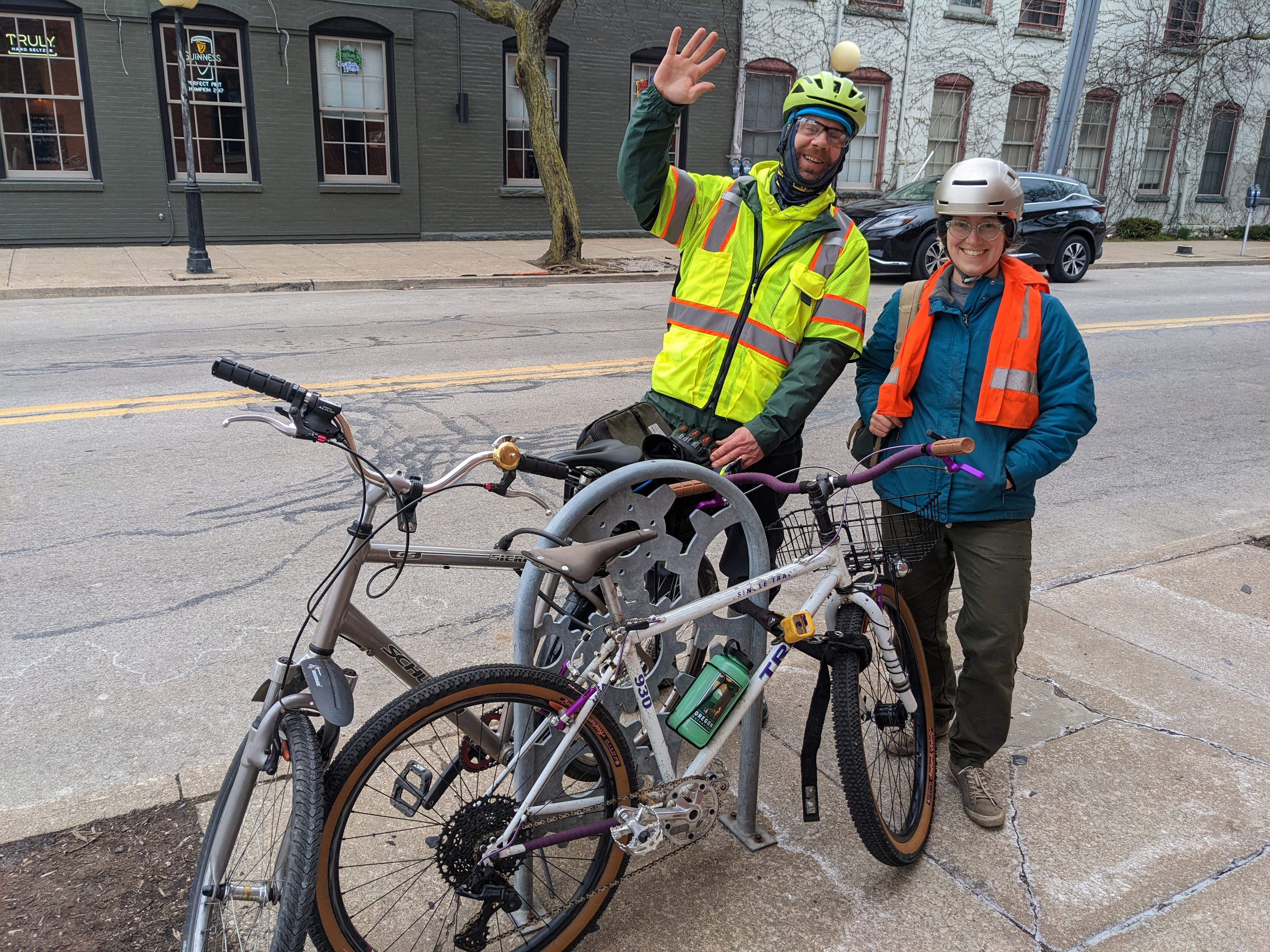 Cyclists Josh Gone (left) and Stephanie Ciner both use their bikes for a majority of their transportation needs in Erie year-round. Both feel safe cycling infrastructure is lacking in Erie and look forward to improved conditions.
Cyclists Josh Gone (left) and Stephanie Ciner both use their bikes for a majority of their transportation needs in Erie year-round. Both feel safe cycling infrastructure is lacking in Erie and look forward to improved conditions.
Why Do People Bike?
Now, if everyone was biking like my family and I did over the past few summers, one might be inclined to believe that what we have in terms of bike routes in Erie is sufficient. If you'd like to ride your bike for leisure, go ahead and take the Frontier/Bayfront path or circle Presque Isle. But not everyone rides bicycles simply for fun. For many, biking is a way of life, and for others it is the only affordable transportation option.
According to census data, over 19 percent of Erie households do not have access to a vehicle — that's nearly one out of every five households. Depending on the neighborhood, that percentage is much higher; for example in Downtown Erie, 65 percent of households have no vehicle available and in parts of East Bayfront and Little Italy those rates exceed 40 percent.
Amanda Gates — vice president of Bike Erie and a member of the Active Erie steering committee — uses her bicycle in combination with public transportation nearly exclusively. At one point in her life, her family owned two cars and found themselves in a constant precarious financial situation. "We were in debt and we had all these goals and we just could not reach them; we couldn't put money away; we couldn't afford an emergency. We had a couple of cars and we realized if we wanted to pay off our debt the cars had to go. As a result, we paid off all our debt — over $20,000 worth of debt — in 18 months."
Owning a car is an incredible expense. The combination of car loan payments, gasoline, parking, routine and emergency maintenance, inspection, insurance, and registration averages upwards of $10,000 a year, according to data collected by AAA. An individual working a full-time minimum wage job in Pennsylvania makes $15,080 a year, so even in the best of all possible scenarios, owning a car for that person will easily take up at least half of their income each year. Gates continues, "There are people who will never be in a financial situation to have a car and there are families that are forced to have a car in this city because Erie is not friendly to any other type of transportation."
Stephanie Ciner, owner and operator of Wild Field Urban Farm on East Seventh Street, has lived without a car since young adulthood. She acquired her first bike upon graduating from college and living in Philadelphia: "It made sense to me as a way to commute to work, a way to go to the store. I lived in Philadelphia for quite a few years before moving here and the infrastructure was so different. Even though there was a lot of traffic, very narrow roads, and it was very busy, it was easy to get around by bike. It was much easier than having a car because you don't have to worry about parking or all the issues that come up with cars. I found it really empowering and also really affordable."
In Erie, Ciner has continued on without a car, running her farm and all that is involved with that (including traveling to and from farmer's markets, gathering and hauling supplies, etc.) from her bicycle (she has a regular pedal bike and also a cargo e-bike for heavier farm-related travel). Ciner continues, "Erie's a hard place to use your bike. Even though we're really set up for it — Erie's relatively flat, it's an easy city to navigate — if some things were different I think a lot more people would make use of a bike in Erie for transportation."
But what about the wintertime? Isn't the bikeability of Erie put on hold for half the year because of our winters? Not according to local cyclist Josh Gone. He has used his bicycle to get to and from work year-round. Gone comments, "I live near the Liberty Plaza and in a five mile radius from there, I can get to all the places I need to go." Gone takes extra precautions for his own safety including wearing a helmet, using proper signals, using reflectors and lights, and wearing head-to-toe reflective safety gear. He feels that kind of basic bike safety is key to navigating the city.
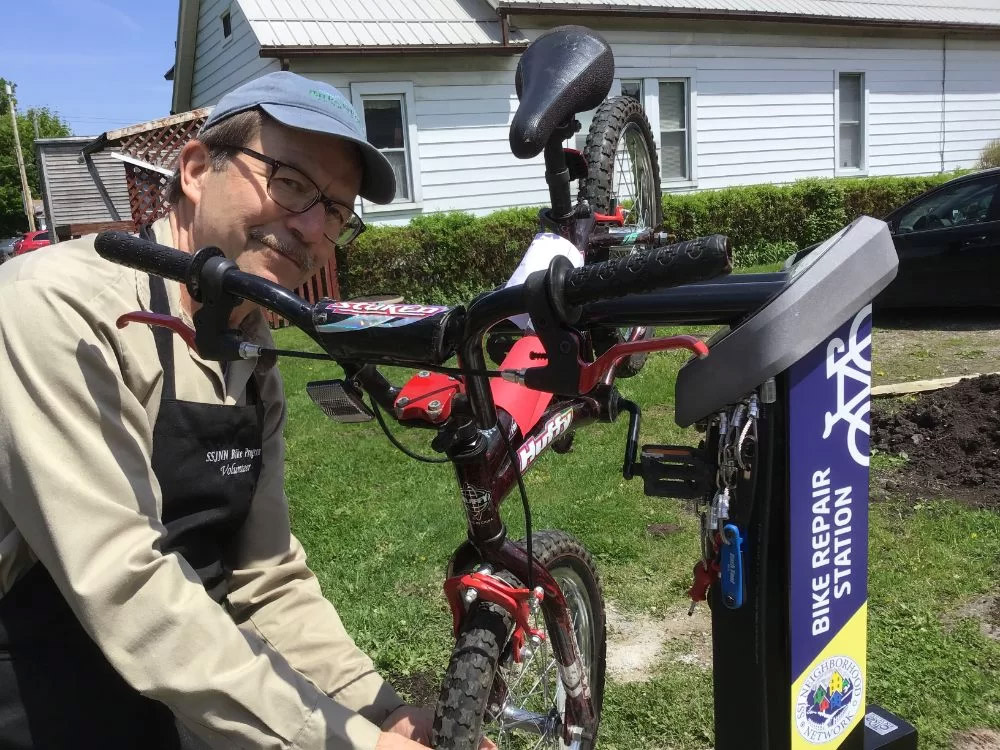 Bicycle training coordinator with the Sisters of St. Joseph Neighborhood Network, Eric Brozell, utilizes a public bike repair station installed at 436 E. 26th St. by the nonprofit neighborhood group. Credit: SSJNN
Bicycle training coordinator with the Sisters of St. Joseph Neighborhood Network, Eric Brozell, utilizes a public bike repair station installed at 436 E. 26th St. by the nonprofit neighborhood group. Credit: SSJNN
Look For the Helpers
Bicycle infrastructure is just one side of the coin for pushing bike advocacy forward in Erie. There are some local organizations that have taken on the responsibility of bicycle safety education, maintenance, youth programs, and large-scale community biking events that puts cyclists and their interests in the spotlight.
The Sisters of Saint Joseph Neighborhood Network (SSJNN) houses the local chapter of the national program Trips for Kids whose mission is to "provide transformative experiences that promote healthy lifestyles, environmental awareness, and personal empowerment for young people of all communities, especially those most in need."
One of the stakeholders on the Active Erie Steering Committee who has also founded the bicycle program through the SSJNN, Eric Brozell, comments on his work with the organization, "The work at SSJNN is about providing safe bicycles to people without access to a decent bike nor an affordable bicycle repair shop nearby. The donated bikes that we provide are used bikes that our skilled volunteers repair to bring up to safe standards."
Brozell continues, "The second part of our program is to provide a repair space. This is complete with all tools required and technical support on how to repair a bike. We also try to help kids with safe bike riding skills. A few times a year we provide a Trips for Kids ride. We provide a bike for the ride, a helmet, lunch, and safe riding instruction. We may ride to the peninsula, a trail, or just around the city." Additionally, since the inception of the organization's bicycle program, they have given out over 300 bikes to refugees who now call Erie home, many of whom have no other reliable access to individual transportation.
Brozell is also a founder of Bike Erie (whose board is currently helmed by Gretchen Fairley, Amanda Gates, and Adam Trott) which is another organization in Erie helping to bring data-driven information to the Active Erie Steering Committee. Bike Erie also works in conjunction with the Erie Sports Commission to help bring cycling-related events to Erie each year with Lake Erie Cyclefest. These Cyclefest events help bring awareness about bike safety, laws, and rights, but also helps spread the word about how fun biking can be, and how it can help contribute to a healthy, enjoyable lifestyle.
2023's Lake Erie Cyclefest is scheduled for July 27-30 and will feature guided group rides for all levels of cycling experience. From the beginner-friendly Downtown Slow Roll (in which my family has participated for the past two years and enjoyed immensely) to the more intense Tour de West County with route options up to 50 miles beginning at Asbury Woods — these events draw hundreds of cyclists from around the area (and many visit from out of town to participate).
For many, biking is a fun way to get around, an activity for leisure or exercise, others depend on their bicycle for a number of reasons (financial, environmental, etc.). While the city ultimately determines the next course of action on the Active Erie plan, it is the hope of the majority of residents (at least 60 percent, given the results of the initial Active Erie survey) that the correct path is taken: one that ensures better safety measures are taken to help protect all vulnerable road users in Erie.
Progress on the Active Erie plan is stalled before the city makes a decision on how to move forward. As of this writing, another public survey recently concluded to obtain the public's input on how the Greengarden project should move forward. The online version of this article will publish any breaking news on this front.
Erin Phillips can be reached at erin@eriereader.com
UPDATE: The results from the most recent survey sent out regarding the bike lane project on Greengarden Boulevard were released by the city on Wednesday, Apr. 5th. Those results are availble to view here: Total-Survey-Responses-4.3.2023
There were a total of 676 people who completed the survey and among all respondants: 485 (or 72%) were in support of bike lanes (with 148 or 22% opposing bike lanes and 43 or 6% reporting neutral). The following graphics were provided for reference by the city:
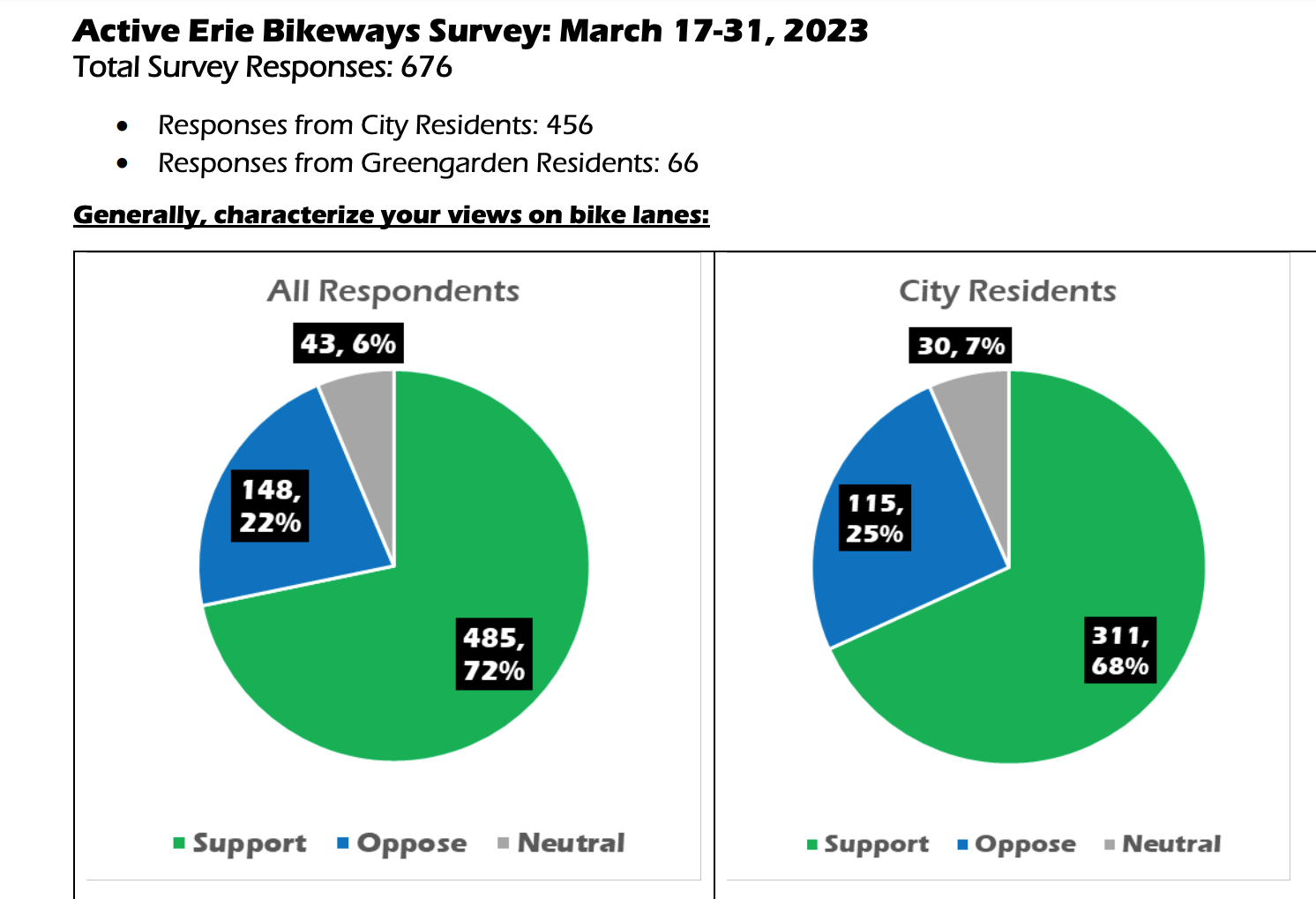
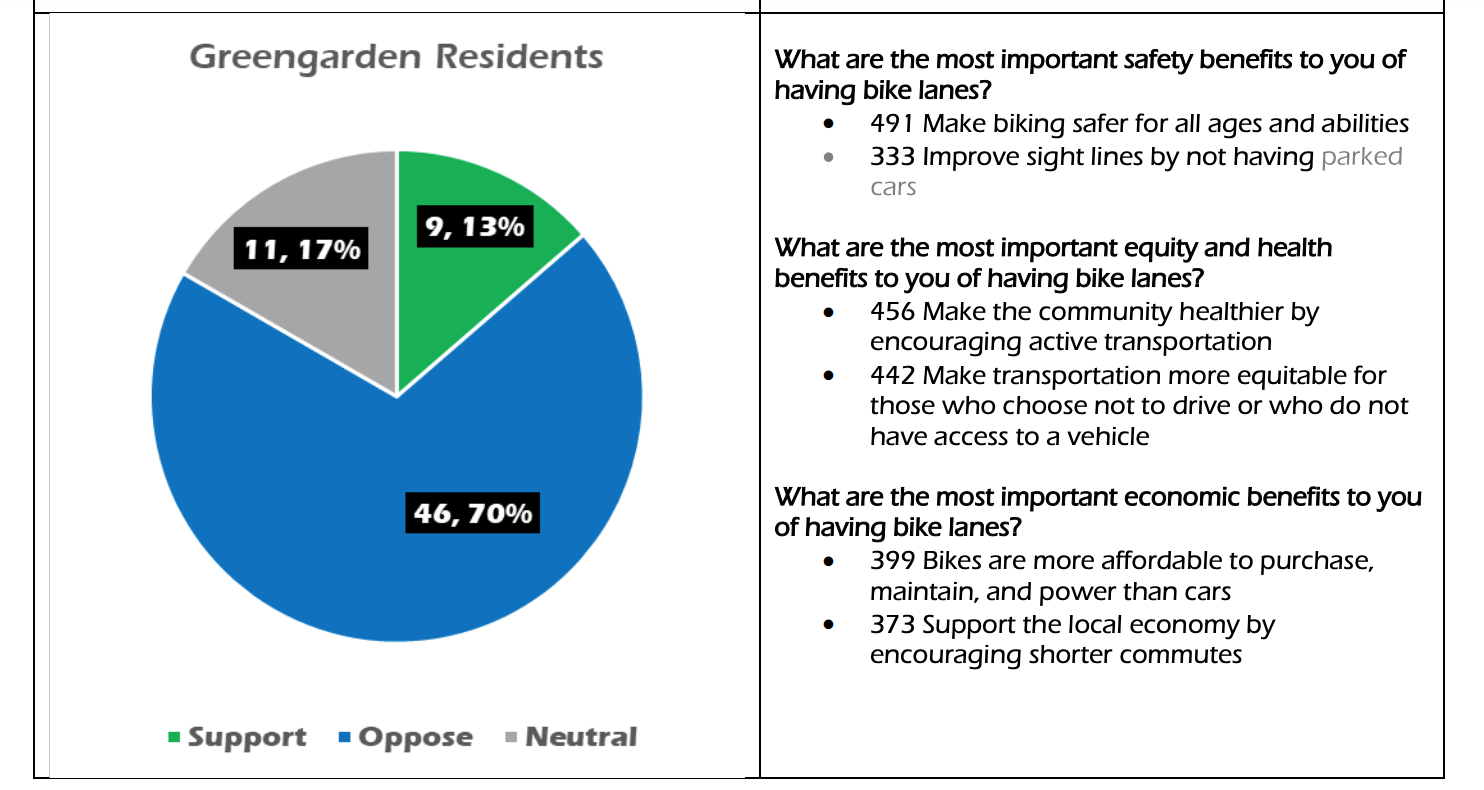
As part of Phase 1 of the Active Erie Bikeway Project, a buffered, painted bike lane with no physical barriers and the removal of on-street parking for Greengarden Boulevard between West 26th and 38th streets will move forward as planned. Mayor Schember, in a statement given on Wednesday, Apr. 5, said "After listening to our consultant and to the public, we are making this recommendation because adding dedicated bike lanes, where we can, and will follow the plan recommendations, make cycling safer, calm traffic and make Erie a more welcoming community for everyone."
